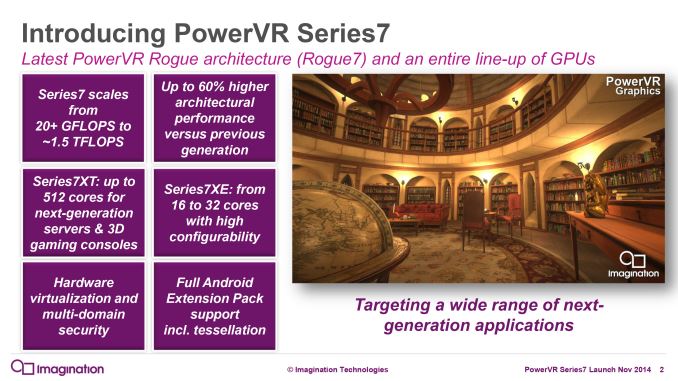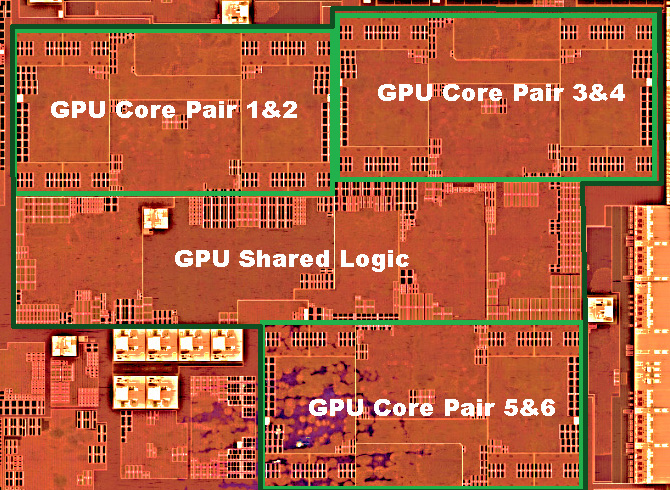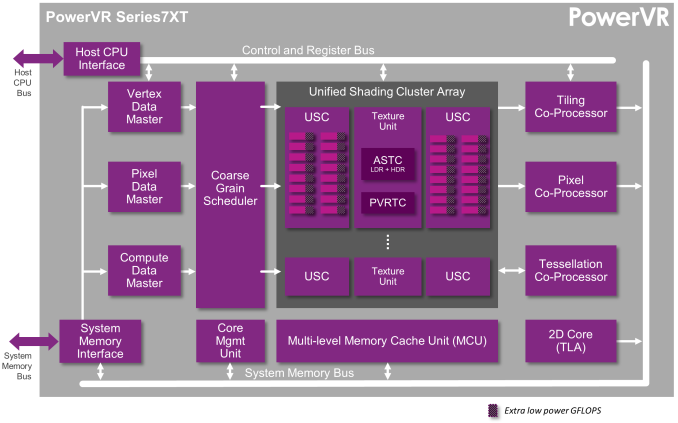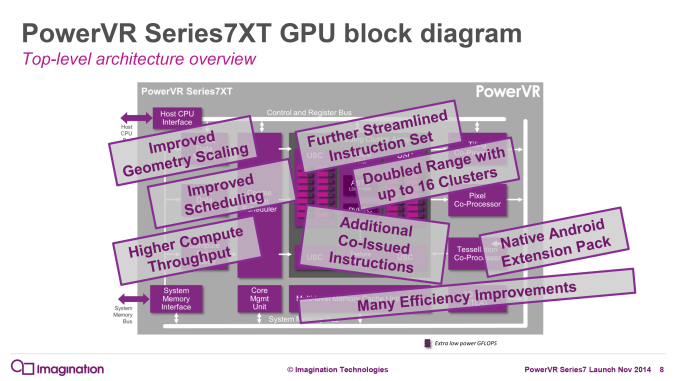The Apple iPhone 6s and iPhone 6s Plus Review
by Ryan Smith & Joshua Ho on November 2, 2015 8:00 AM EST- Posted in
- Smartphones
- Apple
- Mobile
- SoCs
- iPhone 6s
- iPhone 6s Plus
A9's GPU: Imagination PowerVR GT7600
With so much time spent talking about A9 from the perspective of its manufacturing process and its Twister CPU, it’s all too easy to forget that Apple has been working on far more under the hood than just CPU performance. As has been the case for generations now, Apple continues to focus on GPU performance, laying the groundwork for significant performance improvements with every generation.
Going all the way back to the first iPhone and its Samsung-developed SoC, Apple has been a patron of Imagination Technologies and their PowerVR GPUs. This has been a productive relationship for both parties, and for A9 this hasn’t changed. To no surprise then, the GPU in the A9 is another design in Imagination’s PowerVR Rogue family, the GT7600.
Briefly, while Apple continues to not disclose the GPU used in their designs – referring to the A9’s GPU as iOS GPU Family 3 v1 – a look at the iOS Developer Library makes it clear what GPU family is being used. Apple still uses tile-based deferred rendering GPUs (to which only PowerVR fits the description), so the only real questions are which family is in use and how many cores are present.
With A8 and its GX6450, there was a pretty clear smoking gun to identify the GPU family via the inclusion of ASTC support, a feature only available on Series 6XT and newer GPUs. There aren’t any such smoking guns on the A9, but the Metal Feature tables indicate that there are a handful of new low-level features which are indicative of a newer revision of the PowerVR Rogue architecture. Coupled with the fact that Imagination announced PowerVR Series 7 nearly a year ago and Apple has proven to be able to implement a new PowerVR design in under a year, and it’s a safe bet that A9 is using a Series 7 design.
As for the configuration, the A9 die shot quickly answers that one. There are 6 distinct GPU cores on the A9 die, divided up into 3 pairs with a shared texture unit in between them. So it may have taken Apple a generation longer than I initially expected, but with A9 we’re finally looking at a 6 core GPU design for the iPhone.
From a feature and design standpoint then, the GT7600 is not a significant departure from the GPUs in the A8 and A7 SoCs, however it does have some notable improvements along with some optimizations to boost performance across the board. Notably, relative to the GX6450 it features a geometry tessellation co-processor as a base feature, a function that was merely optional on Series6XT and, at least in Apple’s case not used. Unfortunately, looking through Apple’s developer documentation it does not appear that tessellation support has been added for Metal, so assuming for the moment that Apple hasn’t stripped this hardware out, they definitely don’t have API support for it.
Otherwise the bulk of Imagination’s focus has been on small tweaks to improve the Rogue architecture’s overall efficiency. Among these, the Special Function Units can now natively handle FP16 operations, saving power versus the all-FP32 SFUs of Series6XT. SFU operations can now also be co-issued with ALU operations, which improves performance when SFUs are being issued (which in Imagination’s experience, has been more than expected). Finally, the Vertex Data Master (geometry frontend), Compute Data Master (compute frontend), and the Coarse Grain Scheduler have all been updated to improve their throughput, and in the case of the scheduler improving its ability to keep USCs from stalling on tile-interdependencies.
Looking at the broader picture, after initially being surprised that Apple didn’t jump to a 6 core design with A8, with A9 it makes a lot of sense why they’d do it now. GPUs have and continue to be the biggest consumers of memory bandwidth in high-performance SoCs, to the point where Apple has outfit all of their tablet-class SoCs with a wider 128-bit memory bus in order to feed those larger GPUs. Conversely, a 64-bit memory bus with LPDDR3 has always represented a memory bandwidth limit that would bottleneck a more aggressive GPU design. With the move to LPDDR4 however, Apple has doubled their memory bandwidth, and coupled with the larger L3 cache means that they now have the means to effectively feed a larger 6 core GPU.
Overall then, between the 50% increase in the number of GPU cores, Imagination’s architectural efficiency improvements, Apple’s own implementation optimizations, and what I don’t doubt to be at least a decent increase in the clockspeed of the GPU, Apple is promoting that A9 should see an incredible 90% increase in GPU performance relative to A8. And as we’ll see in our performance benchmarks, they are more than capable of delivering on that promise.
| Mobile SoC GPU Comparison | ||||||||
| PowerVR SGX 543MP3 | PowerVR G6430 | PowerVR GX6450 | PowerVR GT7600 | |||||
| Used In | iPhone 5 | iPhone 5s | iPhone 6 | iPhone 6s | ||||
| SIMD Name | USSE2 | USC | USC | USC | ||||
| # of SIMDs | 12 | 4 | 4 | 6 | ||||
| MADs per SIMD | 4 | 32 | 32 | 32 | ||||
| Total MADs | 48 | 128 | 128 | 192 | ||||
| Theoretical GFLOPS @ 300MHz |
28.8 GFLOPS | 76.8 GFLOPS | 76.8 GFLOPS | 115.2 GFLOPS | ||||
| Pixels/Clock | N/A | 8 | 8 | 12 | ||||
| Texels/Clock | N/A | 8 | 8 | 12 | ||||














531 Comments
View All Comments
TitaniK - Friday, November 13, 2015 - link
I used to be so pro android and have tried all main phones on the market; Samsung 3&4, note3,4, htc one m7, nexus 4. I need my phone constantly mainly for business as well as pleasure and at the end, i surrendered to Apple product; so reliable, fast and just clean. It's just a well tuned machine. I compare it this way; android is the NASCAR of mobile devices where Apple is Formula 1. Cars go very fast in both organizations but the Formula 1 machines are simply finer tuned and polished machines.10basetom - Sunday, November 8, 2015 - link
Even though my last two phones have been Androids, I would have to agree with the reviewer's assessment that Android phones have been, more or less, a zero sum game. You can call me jaded, but there's not a single Android phone in the past year that has gotten me truly excited, maybe with the exception of potentially cheaper (relative to YotaPhone 2) dual screen phones coming out of China that would change how you use a phone on a daily basis. PDAF, laser autofocus, and RAW support are nice specs to have for a limited group of photography aficionados, but I don't consider them real innovation in the overall user experience department. Most consumers (i.e., non-geeks) who use phones to take everyday photos will not notice -- or even care -- whether their phone has PDAF or not; and for people who want to take frameable photos, they would probably do so with a tripod and DLSR rather than a mobile phone. Besides, the cameras in the iPhone 6s' are nothing to laugh at.When I think of progress in mobile OS usability, it would have to be something that gives the end user more pleasure in using it, or increase their productivity in a measurable way (e.g., less time in doing something, fewer taps). Maybe I've just been using Android for too long, but there is nothing in Lollipop or what I've seen of Marshmallow that makes me stop and silently shout "damn, that is impressive!". Sure, the interface is a little more streamlined with enhanced jazzy animations (that I turn off anyway to improve performance), and some new iterative features sprinkled here and there, but nothing revolutionary. It's unfortunate that most Android phone manufacturers build a custom skin on top that more often than not makes the phone less usable and more buggy, and also more confusing when you move from one Android phone to the next.
The WinCE-based Neno OS that introduced a 100% swipable interface and weaned people off the stylus two years before the original iPhone -- that's way into revolutionary territory. The pulley menu system in Sailfish OS -- now that's something refreshing. It may not be everybody's cup of tea, but at least they are trying something different, and when you do get used to it, it really does improve one-handed usability. The 3D Touch interface in the new iPhones? Now that's bordering on revolutionary. Again, it may not seem apparent when you first use it, but after living with it for an extended period of time until it becomes habit, you would be hard-pressed to go back to a mobile phone without a pressure-sensitive touch layer. The exciting thing is that we are just scratching the surface of what 3D Touch can bring; and the module could be made thinner and lighter so that future iPhones won't get such a large weight bump.
Other than the superior A9 SoC which has already been widely discussed, the other big thing for me that Android phones have been dropping the ball on is storage architecture. Whereas most Android phones are still advertising eMMC 5.0 storage solutions, the iPhone 6s' have moved way beyond that. Samsung's move to UFS 2.0 is a step in the right direction, and I hope all other Android phone manufacturers will follow suit soon.
dusszz - Monday, November 30, 2015 - link
I've been a long time android user seriously thinking of switching to iphone. Android OS in general is not meant for high end devices because prior to nexus 6p, android is designed for nexus phone which is not a high end devices. The high end iteration of android as in galaxy s6/note 5 with skins feel fragmented and does not really in line with what google intended (material design). Sure they add features with that but it felt like they (high end oem) trying too hard to compete. I always feel the best android devices must come from nexus line but then it does not quite there at least just yet. Every innovation in android OS always feel like it is in beta because the implementation more for marketing rather than useful. For example, nexus 5 has OIS since 2013 but does not feel it has advantage over other phone that has EIS. Furthermore, decision google made to ditch OIS (nexus 6p/5x) further clarify it. I personally never have android phone for more than a year without feeling outdated in term of hardware. So if you think you buy $500 android phone thinking it can compete with iphone, its going to be disappointing. Android is at its best being a midranger.hans_ober - Monday, November 2, 2015 - link
at last!vFunct - Monday, November 2, 2015 - link
I wish he took proper photo tests.Tip: when testing cameras, do make sure to take photos of people. Don't take photos of brick walls.
You're going to find that most people take photos of people with their phones - at parties, selfies, etc..
A good camera test always includes people shots.
vFunct - Monday, November 2, 2015 - link
Basically you're looking for skin-tone reproduction quality.Klug4Pres - Monday, November 2, 2015 - link
I wonder if next year the Home button will disappear, which would help a lot with the bezeltastic design.zeeBomb - Monday, November 2, 2015 - link
That username...lol.I dunno man, the home button is the staple of iPhone Design since the very original. Might be pretty controversial if you'd ask me.
KoolAidMan1 - Tuesday, November 3, 2015 - link
The fingerprint reader is another big reason. If they can get it to be as fast and accurate as it is right now while reducing home button size then I can see them reducing the bottom bezel.Otherwise you're looking at making their fingerprint reader as flaky and undependable as Samsung or everyone else's
Tetracycloide - Tuesday, November 3, 2015 - link
The nexus 5x has been super solid.